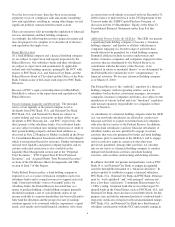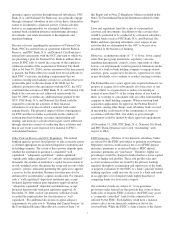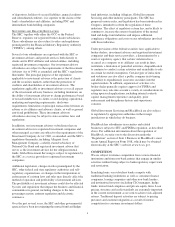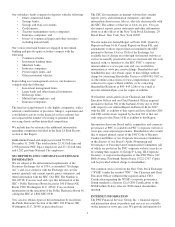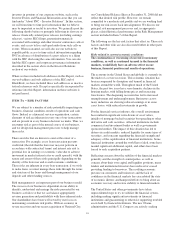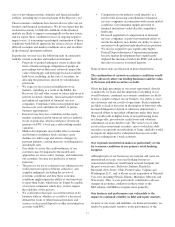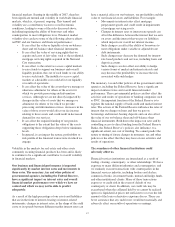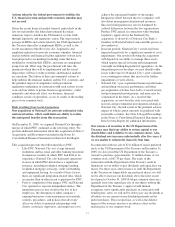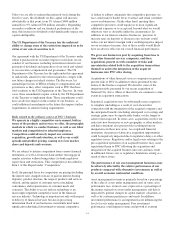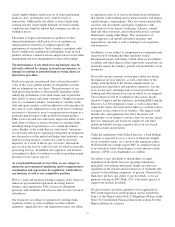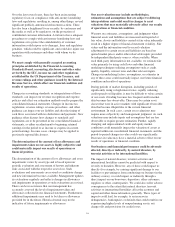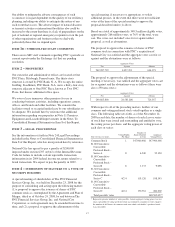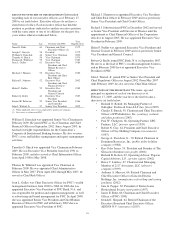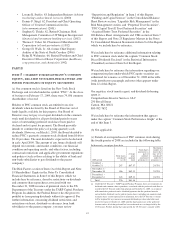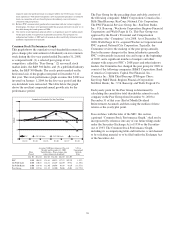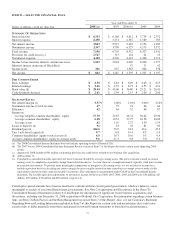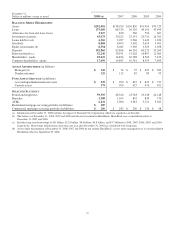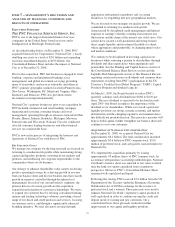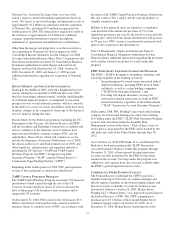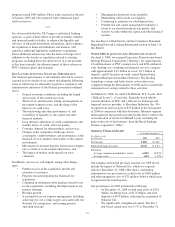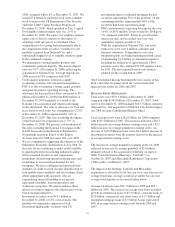PNC Bank 2008 Annual Report Download - page 20
Download and view the complete annual report
Please find page 20 of the 2008 PNC Bank annual report below. You can navigate through the pages in the report by either clicking on the pages listed below, or by using the keyword search tool below to find specific information within the annual report.Over the last several years, there has been an increasing
regulatory focus on compliance with anti-money laundering
laws and regulations, resulting in, among other things, several
significant publicly-announced enforcement actions. There
has also been a heightened focus recently, by customers and
the media as well as by regulators, on the protection of
confidential customer information. A failure to have adequate
procedures to comply with anti-money laundering laws and
regulations or to protect the confidentiality of customer
information could expose us to damages, fines and regulatory
penalties, which could be significant, and could also injure our
reputation with customers and others with whom we do
business.
We must comply with generally accepted accounting
principles established by the Financial Accounting
Standards Board, accounting, disclosure and other rules
set forth by the SEC, income tax and other regulations
established by the US Department of the Treasury, and
revenue rulings and other guidance issued by the Internal
Revenue Service, which affect our financial condition and
results of operations.
Changes in accounting standards, or interpretations of those
standards, can impact our revenue recognition and expense
policies and affect our estimation methods used to prepare the
consolidated financial statements. Changes in income tax
regulations, revenue rulings, revenue procedures, and other
guidance can impact our tax liability and alter the timing of
cash flows associated with tax deductions and payments. New
guidance often dictates how changes to standards and
regulations are to be presented in our consolidated financial
statements, as either an adjustment to beginning retained
earnings for the period or as income or expense in current
period earnings. In some cases, changes may be applied to
previously reported disclosures.
The determination of the amount of loss allowances and
impairments taken on our assets is highly subjective and
could materially impact our results of operations or
financial position.
The determination of the amount of loss allowances and asset
impairments varies by asset type and is based upon our
periodic evaluation and assessment of known and inherent
risks associated with the respective asset class. Such
evaluations and assessments are revised as conditions change
and new information becomes available. Management updates
its evaluations regularly and reflects changes in allowances
and impairments in operations as such evaluations are revised.
There can be no assurance that our management has
accurately assessed the level of impairments taken and
allowances reflected in our financial statements. Furthermore,
additional impairments may need to be taken or allowances
provided for in the future. Historical trends may not be
indicative of future impairments or allowances.
Our asset valuation may include methodologies,
estimations and assumptions that are subject to differing
interpretations and could result in changes to asset
valuations that may materially adversely affect our results
of operations or financial condition.
We must use estimates, assumptions, and judgments when
financial assets and liabilities are measured and reported at
fair value. Assets and liabilities carried at fair value inherently
result in a higher degree of financial statement volatility. Fair
values and the information used to record valuation
adjustments for certain assets and liabilities are based on
quoted market prices and/or other observable inputs provided
by independent third-party sources, when available. When
such third-party information is not available, we estimate fair
value primarily by using cash flows and other financial
modeling techniques utilizing assumptions such as credit
quality, liquidity, interest rates and other relevant inputs.
Changes in underlying factors, assumptions, or estimates in
any of these areas could materially impact our future financial
condition and results of operations.
During periods of market disruption, including periods of
significantly rising or high interest rates, rapidly widening
credit spreads or illiquidity, it may be difficult to value certain
of our assets if trading becomes less frequent and/or market
data becomes less observable. There may be certain asset
classes that were in active markets with significant observable
data that become illiquid due to the current financial
environment. In such cases, certain asset valuations may
require more subjectivity and management judgment. As such,
valuations may include inputs and assumptions that are less
observable or require greater estimation. Further, rapidly
changing and unprecedented credit and equity market
conditions could materially impact the valuation of assets as
reported within our consolidated financial statements, and the
period-to-period changes in value could vary significantly.
Decreases in value may have a material adverse effect on our
results of operations or financial condition.
Our business and financial performance could be adversely
affected, directly or indirectly, by natural disasters, by
terrorist activities or by international hostilities.
The impact of natural disasters, terrorist activities and
international hostilities cannot be predicted with respect to
severity or duration. However, any of these could impact us
directly (for example, by causing significant damage to our
facilities or preventing us from conducting our business in the
ordinary course), or could impact us indirectly through a
direct impact on our borrowers, depositors, other customers,
suppliers or other counterparties. We could also suffer adverse
consequences to the extent that natural disasters, terrorist
activities or international hostilities affect the economy and
capital and other financial markets generally. These types of
impacts could lead, for example, to an increase in
delinquencies, bankruptcies or defaults that could result in our
experiencing higher levels of nonperforming assets, net
charge-offs and provisions for credit losses.
16


